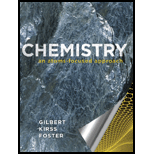
To find:
a) Explain if carbon dioxide is a viable source of the fuel
b) Explain whether the reaction is endothermic.
c) Calculate the value of
d) Explain whether the decomposition of
Answer to Problem 14.119QA
Solution:
a) Carbon dioxide is not a viable source of the fuel
b) The reaction is endothermic.
c) The value of
| Temperature |
|
d) The decomposition of
Explanation of Solution
1) Concept
Given the percentage of decomposition of CO2 at different temperatures and partial pressure of the CO2 at 1 atm, we can calculate the Kp and determine whether reaction is endothermic.
2) Formula:
Here,
3) Given:
i)
ii)
iii) Percent decomposition of
| Temperature |
Decomposition |
4) Calculations:
We can say that the amount of
Where
As the temperature increases, value of
From
RICE table for given reaction:
| Reaction | |||
| Initial | |||
| Change | |||
| Equilibrium | 2x | ||
Change in concentration of
Therefore, equilibrium constant expression for partial pressures for the given reaction is:
Therefore, equilibrium constant expression for partial pressures for the given reaction is:
Therefore, equilibrium constant expression for partial pressures for the given reaction is:
The value of the equilibrium constant increases with increasing temperature, but it is still less than 1. Thus this reaction does not favor products even at a very high temperature, and this is not a viable source of
Final statement:
Using the given
Want to see more full solutions like this?
Chapter 14 Solutions
Chemistry: An Atoms-Focused Approach
 ChemistryChemistryISBN:9781305957404Author:Steven S. Zumdahl, Susan A. Zumdahl, Donald J. DeCostePublisher:Cengage Learning
ChemistryChemistryISBN:9781305957404Author:Steven S. Zumdahl, Susan A. Zumdahl, Donald J. DeCostePublisher:Cengage Learning ChemistryChemistryISBN:9781259911156Author:Raymond Chang Dr., Jason Overby ProfessorPublisher:McGraw-Hill Education
ChemistryChemistryISBN:9781259911156Author:Raymond Chang Dr., Jason Overby ProfessorPublisher:McGraw-Hill Education Principles of Instrumental AnalysisChemistryISBN:9781305577213Author:Douglas A. Skoog, F. James Holler, Stanley R. CrouchPublisher:Cengage Learning
Principles of Instrumental AnalysisChemistryISBN:9781305577213Author:Douglas A. Skoog, F. James Holler, Stanley R. CrouchPublisher:Cengage Learning Organic ChemistryChemistryISBN:9780078021558Author:Janice Gorzynski Smith Dr.Publisher:McGraw-Hill Education
Organic ChemistryChemistryISBN:9780078021558Author:Janice Gorzynski Smith Dr.Publisher:McGraw-Hill Education Chemistry: Principles and ReactionsChemistryISBN:9781305079373Author:William L. Masterton, Cecile N. HurleyPublisher:Cengage Learning
Chemistry: Principles and ReactionsChemistryISBN:9781305079373Author:William L. Masterton, Cecile N. HurleyPublisher:Cengage Learning Elementary Principles of Chemical Processes, Bind...ChemistryISBN:9781118431221Author:Richard M. Felder, Ronald W. Rousseau, Lisa G. BullardPublisher:WILEY
Elementary Principles of Chemical Processes, Bind...ChemistryISBN:9781118431221Author:Richard M. Felder, Ronald W. Rousseau, Lisa G. BullardPublisher:WILEY





